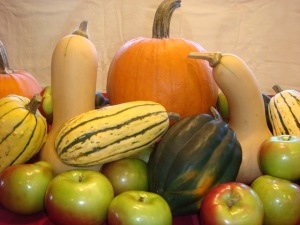 This was a great article from About.com. These tips can prolong the great vegetables you may have grown or selected from your favorite farm stand. Many vegetables will keep for months in cold storage, if you can provide the right conditions. Choose your vegetables well, keep an eye on them through out the winter and don’t be shy about using them. They won’t last forever.
This was a great article from About.com. These tips can prolong the great vegetables you may have grown or selected from your favorite farm stand. Many vegetables will keep for months in cold storage, if you can provide the right conditions. Choose your vegetables well, keep an eye on them through out the winter and don’t be shy about using them. They won’t last forever.
General Storage Rules
Store only fully mature vegetables. Immature fruits and vegetables will rot quickly. Hold off harvesting as long as possible, especially with root vegetables, that can withstand some frost.
Do not store vegetables that have been bruised or nicked or that show the slightest sign of rot. Be careful when handling them.
Remove all excess soil. Don’t wash the vegetables, just let them dry and brush off the soil. You can wash them well before using them.
Thoroughly clean your storage area before each use.
Keep the storage area dark.
Do not expose stored vegetables to temperatures below freezing.
Check on your stored vegetables every week or two. Storage times are just approximations, since vegetables, temperatures and conditions can vary widely.
Use vegetables taken from cold storage as soon as possible. They will not last as long as they would if they had been freshly picked.
Dry vegetables (winter squash, pumpkins, onions, garlic) require less effort to store, but they need more space. Since indoor humidity is generally low during the winter, make use of any unused, dark spaces and corners. These vegetables store best if they are kept up off the floor and are not allowed to touch each other. If you must pile things on top of each other, you will need to check them more frequently.
Moist vegetables (potatoes, root crops, cabbages) should be stored in a container, rather than exposed to air. Traditional methods include storing them in peat, sand, sawdust or newspaper, but you can also use plastic bags or cardboard. If you choose to use plastic, make sure there are a few holes, for excess moisture to escape. To contain the odor of stored cabbages, you can wrap them in a couple of sheets of newspaper first.
An easy way to store these is to fill a cardboard box with about 4 in. of sawdust or other insulating material. Lay a single layer of vegetables on top of that. Do not let the vegetables overlap and keep them about 4 in. from the sides of the box. Add another 2 –3 in. layer of insulating material and another layer of vegetables. Continue layering until the box is almost full. Finish with a 4 in. layer of insulation. If you are worried the temperature will get too cold in your storage area, increase the top, bottom and side insulation to 6 – 8 in. or slip the first box into a larger box, with additional insulation. Since these boxes can be large, using a light insulating material will make them easier to lift and move around.
Root vegetables can be prone to shriveling. Storing them in slightly damp sphagnum moss or plastic bags with a few holes punched in them will help hold in moisture.
You can keep carrots and parsnips in the ground all winter, but you won’t be able to harvest them once the ground freezes.
Winter Squash and Pumpkins – Make sure these are fully ripened, with a rind hard enough to resist being dented with your nail. Leave a couple of inches of stem intact and do not use it as a handle, or you could injure the squash. Allow to cure in a warm, dry, well ventilated spot for about 10 – 14 days, then store in a cool, dark, dry spot where you can spread them out and keep them separate. (Note: acorn squash stores better if not cured before hand.)
For the full article by gardening expert Marie Iannotti, visit http://gardening.about.com/od/vegetable1/a/Storing-Vegetables-For-Winter.htm.
